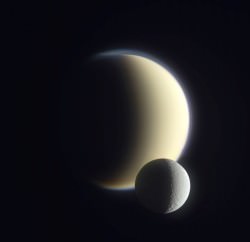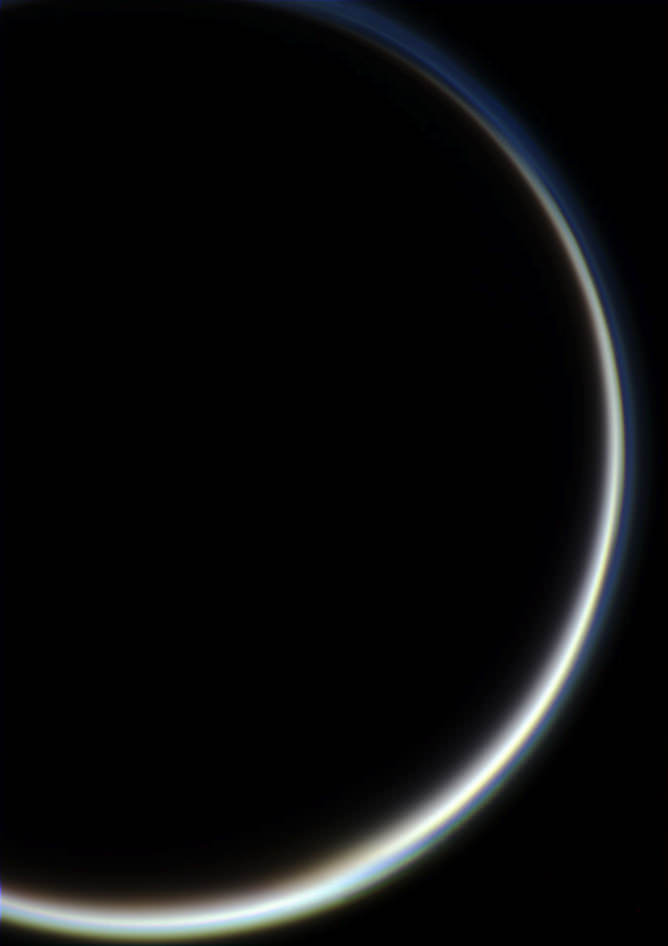[/caption]
Made from one of the most recent Cassini images, this is a color-composite showing a backlit Titan with its dense, multi-layered atmosphere scattering sunlight in different colors. Titan’s atmosphere is made up of methane and complex hydrocarbons and is ten times as thick as Earth’s. It is the only moon in our solar system known to have a substantial atmosphere.
Titan’s high-level hydrocarbon haze is nicely visible as a pale blue band encircling the moon.

At 3,200 (5,150 km) miles wide, Titan is one of the largest moons in the solar system – even larger than Mercury. Its thick atmosphere keeps a frigid and gloomy surface permanently hidden beneath opaque clouds of methane and hydrocarbons.
This image was made from three raw images acquired by Cassini on December 13. The raw images were in the red, green and blue visible light channels, and so the composited image you see here approximates true color.
This particular flyby of Titan (designated T-79) gave Cassini’s instruments a chance to examine Titan in many different wavelengths, as well as map its surface and measure its atmospheric temperature. Cassini passed by the giant moon at a distance of about 2,228 miles (3,586 kilometers) traveling 13,000 mph (5.8 km/sec). Read more on the flyby page here.
Credit: NASA / JPL / Space Science Institute. Edited by Jason Major.
See more color-composite images of Titan and other moons of Saturn on my Flickr set here.


Can anyone tell me why an object this size and density has such a thick atmosphere, whereas the atmosphere on Mars is super thin and wispy? I would have thought that the bigger, denser object would have a much thicker atmosphere.
Saw your question still hanging there, so just one perspective, long-winded answer: Mars may indeed have had a substantial atmosphere in its past history, thick enough to suspend water-clouds of rainfall, evidence uncovered on its dried-out surface seems to indicate, or suggest. My view is that, a massive past episode of destruction wreaked ruin on that outer terrestrial world, not among a few others, and left it so battered, that it declined to become the deep-rozen (somewhat shrunken?) ghost of a world we see today with such amazing robot-delivered detail. Titan too (talk about a winter-wonderland!) may have suffered under the onslaught, but, for whatever reasons, survived with its own over-sized atmosphere (thicker than it orignally was?). Saturn may help explain that.
And I have wondered, if other moons were originally enveloped with lovely atmospheres, in in light of the Solar System’s morning years — before the storm.
It just occurred to me, the gaseous components, and the material make up of worlds, may also play a role, as far as size and density of the planets, and atmosphere retention capability (perhaps stating the obvious).
And look at Dante’s Inferno, Earth’s terrible twin: Venus. If I understand, its atmosphere is so massive, 90x that of Earth (if I recall), with attendant surface pressure, that a visitor might think he was under depth of water — for a split second, before being broiled, asphyxiated, crushed to a pulp, with smoking remains being eaten away by acid rain(?).
But, here likewise, I have read, there is some “wispy” evidence that that world too was far different in the veiled past, when it might have been graced with a global ocean, and massed with continental formations (the baked remnants of which may still be radar-visible — through the howling canopy of hell). And enclosing this truly Earthlike world, a fair atmosphere scented with life potential. But, unlike Mars, its terrible fate was to be buried under a smothering gaseous, burning ocean. That planet went through Vulcan’s fire, and was left in Hell.
That was quite the surreal answer, and rather poetic as well. I think a more succinct answer of temperature vs available atmospheric components gives another answer. Mars likely had a magnetoshere which dissipated as the planet cooled. That would’ve helped retain an atmosphere on a small planet, too small for its gravity to hold onto a carbon dioxide air on its own. Titan is much colder than Mars and farther from the sun so it could make its atmosphere from molecules that would have been too volatile at Mar’s temperatures. Mars is a silicate based surface like our own and Titan is likely ice based like its compatriots in Jupiter orbit. Its unclear how such a thick (almost a thousand kilometers) nitrogen atmosphere is replenished and all bets are still on the table (including life for the small methane content) but clearly, it’s not going anywhere soon. I can hardly wait ’til we drop a blimp into the clouds to really firm up these answers.
Your answer comes from a solid surface of mass, from one perspective view. In other words, it has well-measured weight.
Thanks for the answer. I was also wondering if some of the atmosphere on Titan came from the other moons and maybe even from Saturn, so that it is being replenished somewhat?
Thanks for the replies. My understanding of Venus is that a lot of the material in the atmosphere was once in the rocks and other parts of the planet, but the runaway greenhouse gas effect cooked it out of the rocks & soil and into the atmosphere, which then made the planet hotter.
Excellent question!
The question why Mars lost its atmosphere is not really settled I think, hence IIRC future probes are going to study its atmosphere and its losses some more. What Peristroika describes is the main theory as I understand it.
Atmosphere loss through compactors is difficult AFAIK. The Earth-Moon impactor didn’t remove much volatiles in simulations, but they were retained by Earth. (And the Moon subsequently lost whatever it recaptured.)
We can estimate the difference to Mars to see where the ball park is. Mars has some ~ 0.4 of Earth surface gravity, so I’m going to use g(Mars) ~ 1/2. Newton gravity gives
F = G m1*m2/r^2 = g M/r
for planets.
For the loss radius the forces on gas molecules with mass m is the same. We assume only gravitational losses here for simplicity:
F(Earth) = g(Earth)*m/r(Earth)^2 = F(Mars)=g(Earth)/2*m/r(Mars)^2, so r(Mars) ~ 1/sqrt(2) r(Earth) ~ 0.7 r(Earth).
The difference in captured volume V = 4/3*pi*r^3 would be:
V(Mars)/V(Earth) = r(Mars)^3/r(Earth)^3 ~ 0.7^3*r(Earth)^3/r(Earth)^3 ~ 0.4.
So Mars would loose twice as much volatiles as Earth for large impacts, everything else the same. It isn’t, as Mars has lower orbital speed and hence would experience less energetic impacts. But I don’t feel like adding more rough estimates just to move the ball park a bit.
Being situated closer to Jupiter than Earth, Mars would have been subjected to a larger flow of impactors during the Late Heavy Bombardment. The remains of moons (Phobos, Deimos, highly elliptical equatorial impact scars from deorbited moons) that never gathered to a single Moon tells of at least one large impactor. But none on Mars scale, the scale of the Earth-Moon impactor, or Mars would be larger from aggregation.
So naively I wouldn’t expect impactors to be a huge factor in the atmosphere loss of Mars.
We’ve featured this article in our blog http://drawatriangle.tumblr.com/
Have a nice day!